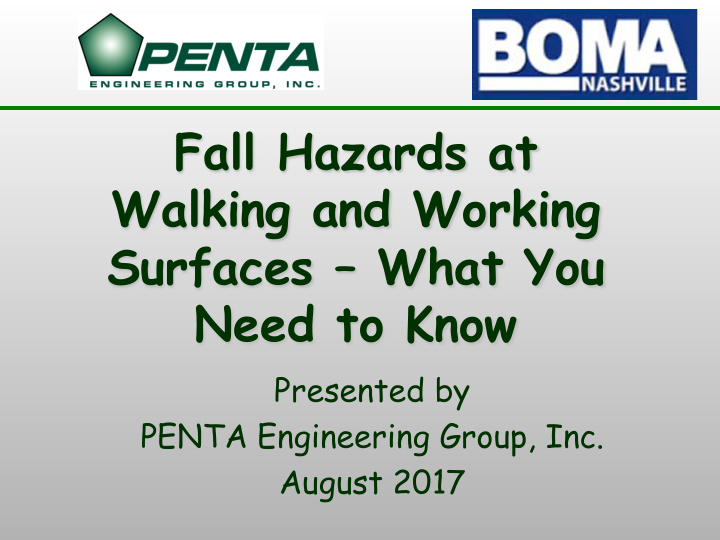



Fall Hazards at Walking and Working Surfaces – What You Need to Know Presented by PENTA Engineering Group, Inc. August 2017
Presenters – Christopher M. Everett, PE President ceverett@pentaeng.com – Michael J. Bridgman Nashville Branch Manager mbridgman@pentaeng.com – Nashville Telephone: (615) 815-0260
Presentation Outline Basics of Exterior Maintenance Regulatory Requirements OSHA 1910 – Subpart D – Walking and Working Surfaces – What Has Changed? Important Dates for Compliance Why Have the Regulations Changed?, followed by Q & A
Basics of Exterior Maintenance
Basics of Exterior Maintenance Rooftop Maintenance – Roof System Repairs – Rooftop Equipment Maintenance – Must provide fall protection at unprotected edges
Basics of Exterior Maintenance Minor Maintenance – Window Washing (semi- annual) – Minor cleaning or caulking – Rope Descent utilizing Tie-back Safety Anchors
Basics of Exterior Maintenance Major Maintenance – Building Construction – Glass replacement or restoration – Wet Sealing, Recaulking (every 10-15 years) – Painting or Repointing – Swing Stage utilizing a Davit System – Scaffolding may also be an option
Basics of Exterior Maintenance What is an anchor? – OSHA CFR 1910.66 “ Anchorage ” means a secure point of attachment for lifelines, lanyards, or deceleration devices, and which is independent of the means of supporting or suspending the employee.
Basics of Exterior Maintenance What Are Davit Systems? – Definitions per OSHA CFR 1910.66 “ Davit ” means a device, used singly or in pairs, for suspending a powered platform from work, storage, and rigging locations on the building being serviced.
Basics of Exterior Maintenance Purpose of Exterior Maintenance Equipment – Access Building Exterior – Access Roof Areas within 15 feet of an Unprotected Edge (i.e. no guardrail/parapet at least 42 inches in height) – Keep Workers and Bystanders Alive!
Basics of Exterior Maintenance Do you Want to Take a Stage Ride?
SO…… WHAT’S BEEN REQUIRED?
Regulatory Requirements Anchor & Davit Requirements – Occupational Safety and Health Administration OSHA 1910 - General Industry Standard OSHA 1926 - Construction Industry Standard – International Window Cleaning Association IWCA I-14.1-2001
Regulatory Requirements OSHA and IWCA Requirements: – Tie-back safety anchors are required for façade access by suspension equipment. – Anchors must be capable of supporting 5,000 pounds per employee attached in any direction they may be used. – Anchorages used for fall arrest equipment must be independent of the means of supporting the employee.
OSHA 1910 – Subpart D – Walking and Working Surfaces What Has Changed?
Rope Descent Systems (RDS) Anchorages – “Before any rope descent system is used, the building owner must inform the employer, in writing that the building owner has identified, tested, certified, and maintained each anchorage so that it is capable of supporting at least 5,000 pounds for each employee attached.”
Rope Descent Systems (RDS) Anchorages (continued) – “This information must be based on an annual inspection by a qualified person and certification of each anchorage by a qualified person, as necessary, and at least every 10 years.”
Rope Descent Systems (RDS) The Use of RDS – “No rope descent system is used for heights greater than 300 feet above grade unless the employer demonstrates that it is not feasible to access such heights by any other means or that those means pose a greater hazard than using a rope descent system.”
Work on Low-Slope Roofs – Less than 6 feet
Work on Low-Slope Roofs – 6 feet to 15 feet
Work on Low-Slope Roofs – Greater than 15 feet
Fixed Ladders – Extend Greater than 24 feet Above Lower Level Existing Fixed Ladders – Each fixed ladder installed before November 19, 2018 must be equipped with a personal fall arrest system, ladder safety system, cage or well.
Fixed Ladders – Extend Greater than 24 feet Above Lower Level New Fixed Ladders – Each fixed ladder installed on and after November 19, 2018 must be equipped with a personal fall arrest system or ladder safety system.
IMPORTANT DATES How Long Do I Have Until I Need to Comply?
IMPORTANT DATES
Why? Why Have the Regulations Changed?
Why? Construction Deficiencies: Plywood anchor rod templates were inadvertently left behind and trapped moisture. This condition accelerated corrosion of anchor rods. The rods failed during load testing.
Why? Dissimilar Materials: A galvanic reaction occurred due to a lead washer being installed on a carbon steel threaded rod for waterproofing.
Why? Field Fabricated Anchors: Anchor failed at less than 1,000 lbs. during load testing. OSHA required ultimate load is 5,000 lbs.
Why? Roof Carriage Track: System in place for many years and had been previously tested. Track had never been welded down in one location.
Why? Field Fabricated Anchor: Anchor failed at less than 800 lbs. during the load testing. OSHA required ultimate load is 5,000 lbs.
Why? Fall Hazard at Roof Hatch: Workers exiting roof hatch are within 6 feet of an unprotected edge and are immediately exposed to a fall hazard.
Why? Is this an Anchor?
Q & A THANK YOU FOR YOUR TIME! Questions & Answers
Recommend
More recommend